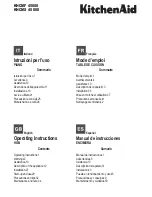
19
3 - 4
• reheating
• rapid simmering
• cooking rice
5 - 6
• pancakes
7 - 8
• sauteing
• cooking pasta
9
• stir-frying
• searing
• bringing soup to the boil
• boiling water
Care and Cleaning
What?
How?
Important!
Everyday soiling on
glass (fingerprints,
marks, stains left by
food or non-sugary
spillovers on the glass)
1. Switch the power to the
cooktop off.
2. Apply a cooktop cleaner
while the glass is still
warm (but not hot!)
3. Rinse and wipe dry with a
clean cloth or paper
towel.
4. Switch the power to the
cooktop back on.
• When the power to the cooktop
is switched off, there will be no
‘hot surface’ indication but the
cooking zone may still be hot!
Take extreme care.
• Heavy-duty scourers, some
nylon scourers and
harsh/abrasive cleaning
agents may scratch the glass.
Always read the label to check
if your cleaner or scourer is
suitable.
• Never leave cleaning residue
on the cooktop: the glass may
become stained.
Boilovers, melts, and
hot sugary spills on
the glass
Remove these immediately
with a fish slice, palette knife
or razor blade scraper
suitable for ceramic glass
cooktops, but beware of hot
cooking zone surfaces:
1. Switch the power to the
cooktop off at the wall.
2. Hold the blade or utensil at
a 30° angle and scrape
the soiling or spill to a
cool area of the cooktop.
3. Clean the soiling or spill up
with a dish cloth or paper
towel.
4. Follow steps 2 to 4 for
‘Everyday soiling on glass’
above.
• Remove stains left by melts and
sugary food or spillovers as
soon
as possible. If left to cool on
the
glass, they may be difficult to
remove or even permanently
damage the glass surface.
• Cut hazard: when the safety
cover
is retracted, the blade in a
scraper
is razor-sharp. Use with
extreme
care and always store safely
and
out of reach of children.
Содержание YL-CD3201
Страница 115: ...115 ...
















































